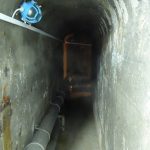Christian Pleijel reflects on a spectacular tour into the techno-mythical world of water on the island of Vis in Croatia.

Vis, a Croatian island in the Adriatic Sea, 55 kilometers from the mainland, with an area of 90 km2. 3,460 persons live in the island’s two municipalities. Ten times the population comes to visit every year = 36,750 tourists, spending some 200,000 person-days on the island.
The pressure on the islands’ freshwater system (as well as the systems for energy distribution, sewage, solid waste, roads, ports, telephones, internet, transports, postal services and healthcare) from tourism is not so high, compared to most Mediterranean islands. The amount of water needed for the island can be estimated to 139,000 m3 (139 million liters) a year.
The islanders get their freshwater from two locations: five 160 metres deep drilled wells at Korita located in the interior of the island, and the fresh water spring called Pizdica which is located close to shore in the bay of Komiža, deep inside the 587 metres high mountain Hum.
To visit the source, you leave the road at a height of about 250 meters and descend on a pathway which becomes a serpentine trail down the mountainside. Getting more rugged, with simple stairs, plateaus, risk to slip and dope. There are wild roses, blackberries, hedge flowers, rosemary and St. John’s wort. Through many turns, bends and staggering dumps, you eventually land on a beach with decayed buildings.
Vis was a floating fortress with bunkers and caves for torpedo boats during Yugoslav time. No visits were allowed. The Pizdica source was the only known natural water resource of the island and therefore carefully guarded by the military, who had a posting here and carefully guarded it from attacks of all kinds. Two iron doors 50 meters apart close the double entrance to the spring, connected by a half-moon-shaped gallery, built to bear the pressure of a 500 kiloton bomb. A heavy steel door leads into today’s pumping room, where a small side door leads through a long narrow tunnel deep into the mountain, with the water pipe from the source on the floor. It is dark with simple lamps every ten meters. The passage turns once more. The pipe has taps into the mountain. You hear the water gurgle, and, after another bend, you are at the source.
It is a small basin, 2 x 2 meter, one meter deep, giving 4 litres per second during summer, 3-4 times more winter time. The water is cold and clear and has a slight taste of salt.
It is spectacular. First the steep descent, then the jealous, oversized steel and concrete defense of the source, then today’s impressive engineering solution to extract the water of the source, finally at the bottom of the mountain the ancient, mysterious source, the holy origin of life. The Croatian word Pizdica literally means “small vagina” and the spring is referred to as the “pussy fountain”.

We can choose to look at water from many angles. From an engineering point of view, drinking water is a precious provision which has to be found, extracted, purified and distributed among us humans. From a more poetic perspective, a freshwater spring is not only a subterranean spring but also a subconscious, important source of a myth, a legend, poetry, music, dreams and nightmares.
At Pizdica the myths seem to have combined in curious ways over time. Modern engineering ideals and military manifestations of dated geopolitics blend with traditional folklore echoing masculine dominance. Regardless what perspective we choose, the story of water on the island of Vis is one about a precious resource that needs to be safeguarded. Steel doors or not.
Christian Pleijel is Vice President of the European Small islands Federation. He works with leadership and development on island communities in Europe, including the challenge of water: https://europeansmallislands.com/water-saving-project/
christian.pleijel@es.kth.se




Thank Christian for an interesting and different perspective. Sorry we had to take away the word “Pussy” from the title due to complaints from management.
Thanks also for the interesting seminar “Thinking Inside the Box” you held on KTH on Feb 1. https://www.water.abe.kth.se/events
David Nilsson, WaterCentre@KTH